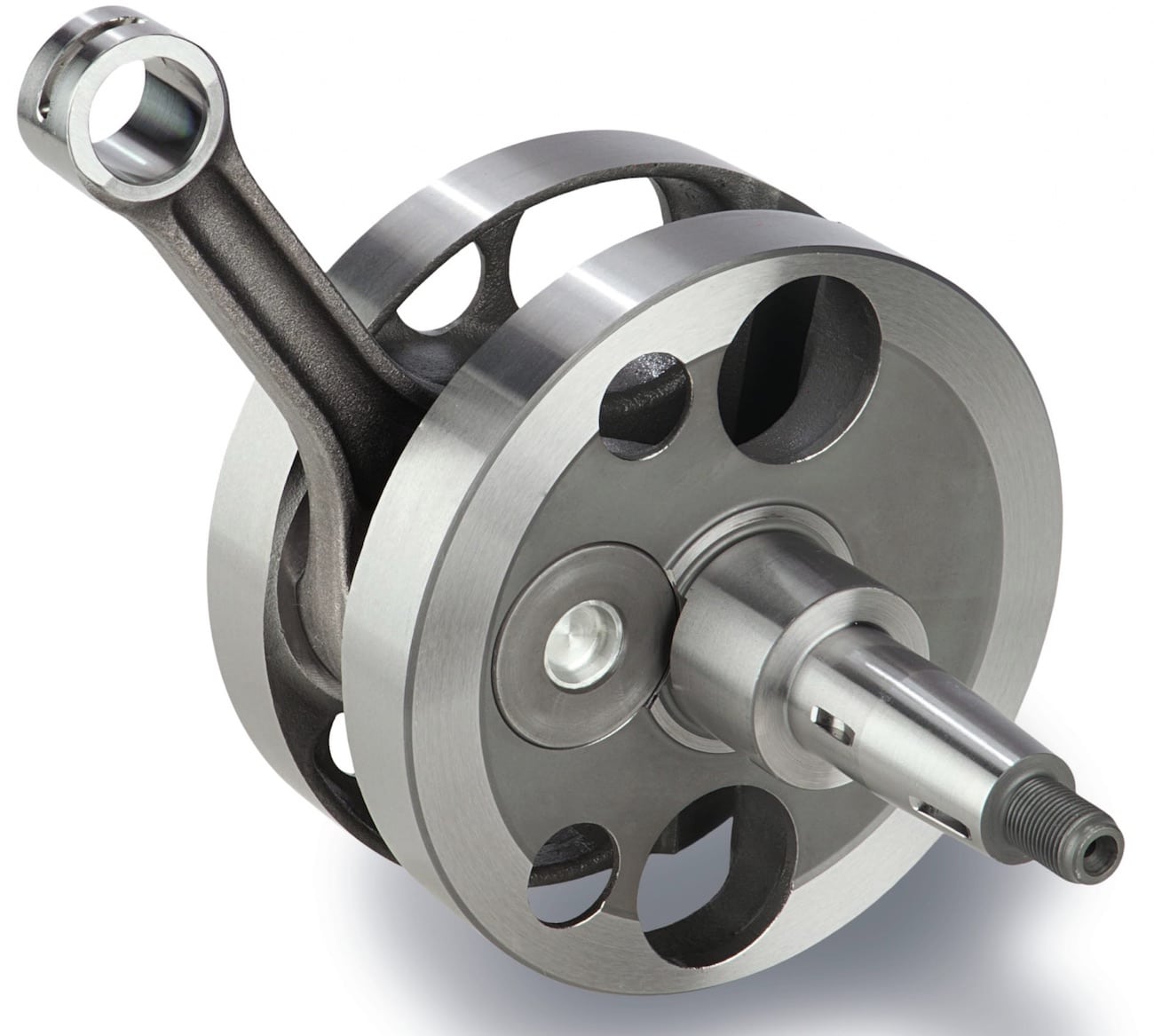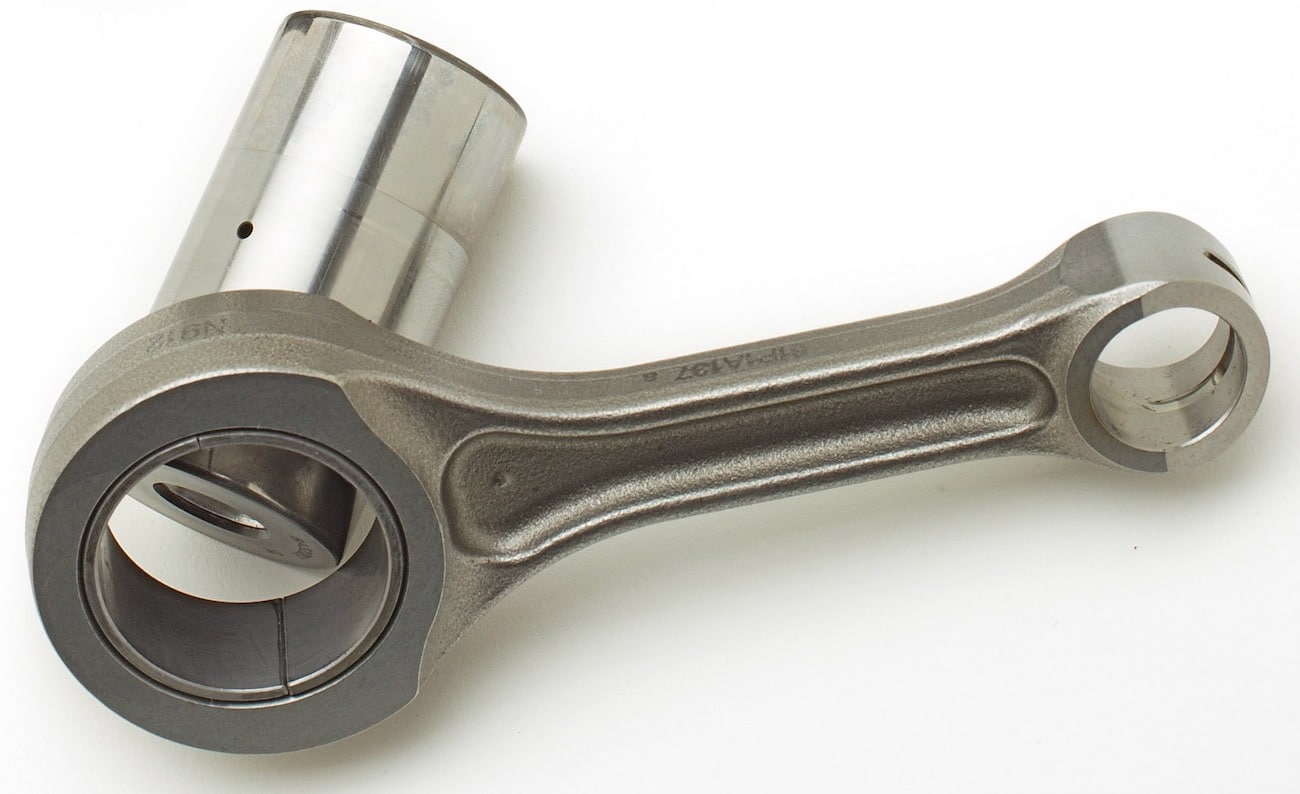TEN THINGS YOU NEED TO KNOW ABOUT CONNECTING RODS
 (1) Connecting rod. A connecting rod is the link between the piston and the crank. Connecting rods are constantly under heavy loads while moving up and down inside of the cylinder, raising and lowering the piston while rotating with the crankshaft. Increased horsepower, whether through a high-compression piston, aggressive camshaft timing, exhaust pipe or other modifications, will magnify the load on the rod.
(1) Connecting rod. A connecting rod is the link between the piston and the crank. Connecting rods are constantly under heavy loads while moving up and down inside of the cylinder, raising and lowering the piston while rotating with the crankshaft. Increased horsepower, whether through a high-compression piston, aggressive camshaft timing, exhaust pipe or other modifications, will magnify the load on the rod.
(2) How rods are made. The best connecting rods are forged. The high-pressure method of forging aligns the grain structure of the material to make it stronger; however, forging isn’t cost effective unless a company is producing thousands of the same rod. Crank Works CNC machines its rods from billet and then completes an extensive heat-treating and shot-peening process to increase strength.
(3) Long rod. A longer rod improves midrange and high-rpm power (without changing the engine’s displacement). A longer rod relieves some of the stress on the piston and cylinder; however, a longer rod can become detrimental if you’re not pulling enough air into the engine to make up for it. In 2020, Yamaha added a 1.5mm-longer rod to its YZ450F. With it, friction was reduced by 2 percent, resulting in less heat, quicker rev and a major reduction in decompression braking when coasting into corners.
(4) Shorter rod. Compared to old-style four-stroke engines, a modern engine has a very short stroke and big bore. While a longer connecting rod creates a smoother rotation through the cylinder, a shorter rod thrusts the piston against the cylinder walls at a steeper angle, creating more drag and engine braking while allowing for higher rpm. The shorter rod is also exerting more stress on the piston, rings and wrist pin, which hinders durability. Sometimes, long-rodding an engine will reduce bottom-end power, which means that a shorter connecting rod can be easier to ride with for less experienced riders.
(5) Stroker engine. The connecting rod is connected to the crank by a pin. Aftermarket engine tuners use companies like Crank Works to move the rod’s big end to a new location on the crank, increasing or decreasing its radius to lengthen or shorten the engine’s stroke. This is called “stroking the engine.” Lengthening the stroke increases the amount of air and gas that can fit in the cylinder. Additionally, with a longer stroke, you’ll need to install a spacer under the cylinder and mill the head to make more room in the cylinder.
(6) Rotating mass. Most people are surprised to find out how much a motorcycle’s engine affects its ability to corner. The rotating metal parts inside the engine create a gyro effect, acting like a spinning top that wants to always return to straight up. The lighter a spinning top is, the easier it is to knock it over. The heavier a top is, the harder it is to tip it over. In the same way, an engine with heavy rotating parts wants to stand up in mid-corner when the throttle is turned. Instead of staying planted in a rut, the bike will lift. A lighter connecting rod can improve handling while increasing throttle response and horsepower.
(7) Bearings. With a piston making over 200 rotations per second, immense loads are placed on the connecting rod and its bearings. A rod’s strength and its ability to rotate smoothly at both ends are crucial. Standard two-stroke connecting rods use needle bearings on the top and bottom ends. Four-stroke pistons have to travel up and down twice as often, which increases wear. Four-strokes previously used needle bearings on the top and bottom of the rod, but lately engine designers have switched to bushings (plain bearings) on the top and bottom to increase durability. The extra stroke without spark on a four-stroke could destroy a top-end needle bearing.
(8) Stock. In 2020, KTM switched from a coated top-end rod bushing to bronze bushings on its four-stroke models to increase durability. Yamaha, Kawasaki and Honda currently use friction-reducing coatings on their top-end rod bearings.
(9) Tolerances. Tighter tolerances reduce piston rock and flutter, which helps when a tuner is searching for minute horsepower gains. Tighter tolerances also lessen horsepower loss. If the wrist pin is too loose, it allows the piston to rock back and forth, and the rings will not seal correctly in the bore.
(10) Offset crank. Most people believe that the piston is mounted directly in line with the center of the crank. Not true. In recent years, there has been a move to have the piston offset radially to the crank (perpendicular to their rotational axis). In most cases, the piston is offset several millimeters towards the exhaust side of the cylinder. Why? The constant stopping and starting of the piston imposes stress on the crank, rod and piston. By moving the piston off-center, the reciprocal load is reduced. The goal of offset cranks is to reduce friction, and friction is at its highest during the combustion stroke because the piston is thrust into the side of the cylinder with the most force. The engine designer targets a specific rpm range, the one that he assumes riders use the most (between 5000 rpm and 8000 rpm), and then chooses the number of millimeters of offset to match that target rpm range. For example, a Yamaha YZ450F crank is 12mm in front of the centerline of the cylinder.






Comments are closed.